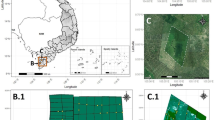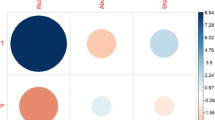Abstract
A multiple-catch trap (a tub, like a mason's bucket e. g.) is described, the entrance-device of which has been developed by the Department of Forest Protection in the Lower Saxonian Forest Research Centre. The trap-tubs, in this experiment containing 3 entrances each at their bottom level, are to be placed in a square pattern of 30×30m or less on the ground of vole endangered forest regeneration areas including adjacent field vole habitats, in order to prevent field vole populations from developing to high damage causing densities.
The pending flap inside the square-shaped plastic entrance tube, made of thin metal bars, does'nt seem to be an obstacle for the vole and seduces it (even without a lure, simply driven by it's curiosity) to enter the tub from where the rodent will not be able to reopen the flap by it's front paws (as field voles are well able to do with other types of flaps), due to the special form of the newly developed flap.
A first field test to prove function and trapping efficiency resulted in a catch of 97 field voles per ha (including home range) within 4.5 months which is very high compared to the 100 field voles per ha reported to be the maximum density in Germany. Non-targets have not been trapped, longtailed mice belonging to a protected genus are able to leap easily out of the tub and even to open the pending flap from inside.
Voles will not survive after being trapped for more than a few hours, due to natural factors as undercooling (especially when fur is wettened) and/or shock, both of these factors assumed to cause less pain than being poisoned.
A second experiment at the same area during a bank vole gradation and with low field vole densities proved the tubs containing 3 entrances to catch 2.5 (field vole) resp. 2.9 (bank vole) times more voles than tubs with one entrance only.
Catches per ha were high again: field vole 43.3, bank vole 39.7 individuals-but without any experimental devices to prevent voles from filling up the emptied parts of the small trapping area.
Zusammenfassung
Es wird eine Mehrfachfang-Lebendfalle (Fangwanne) vorgestellt, deren Einlaßgehäuse mit Fangklappe von der NFV, Abteilung Waldschutz, entwickelt wurde. Das Gerät soll im Verband 30×30 m oder enger auf erdmausgefährdeten Verjüngungen einschließlich benachbarter Erdmausbiotope oberirdisch (nicht eingegraben!) aufgestellt werden, um den Aufbau schadenverursachender Erdmausdichten zu verhindern. Die Fangklappe im Einlaßgehäuse ist so konstruiert, daß die Mäuse sie offenbar nicht als Hindernis wahrnehmen und auch ohne Anlockung durch Köder unter ihr hindurch in das Innere der Fangwanne schlüpfen. Eine gefangene Wühlmaus kann die Klappe aufgrund ihrer besonderen Form nicht von innen hochschleudern, um zu entweichen (was Erdmäuse bei anderen Klappenkonstruktionen sehr wohl können).
Ein erster Freilandversuch vom 23. 9. 95–11. 2. 96 (während einer Erdmausgradation) sollte Fangleistung und Gerätefunktion prüfen: in 18 Fangwannen, deren jede 3 bodengleiche Einlaßgehäuse aufwies, fingen sich 144 Erdmäuse (=97,3/ha) in 4,5 Monaten-ein sehr hoher Wert, gemessen an Literaturangaben, wonach Erdmäuse (in Süddeutschland) maximal eine Dichte von 100 Individuen/ha erreichen. An Rötelmäusen wurden 30 (=12,4/ha) gefangen.
Außer 4 Langschwanzmäusen (die aus der Wanne an sich leicht herausspringen und sogar die Klappe von innen öffnen können) wurden unerwünschte Beifänge nicht getätigt. Dies steht in deutlichem Gegensatz zu einem ebenfalls von der NFV im Freiland getesteten, bekannten Fangwannentyp, der eingegraben werden muß und wie eine Fallgrube arbeitet.
Die gefangenen Mäuse sterben an Unterkühlung (vor allem bei nassem Fell)-und wohl auch an Schock-innerhalb weniger Stunden, selbst wenn Nahrung (z. B. Möhren) geboten wird. Entnahmen durch Predatoren sind tagsüber vermutlich bei 2 zuvor toten Erdmäusen vorgekommen, nächtliche Entnahmen durch Mäusefresser wurden nicht gezielt untersucht.
Eine ab 1. 4. 96, kurz vor dem Zusammenbruch der Erdmauspopulation, am selben Ort durchgeführte sechseinhalbmonatige Versuchsserie mit je 7 Fangwannen mit 1, 2 und 3 Einlaßgehäusen erbrachte den Nachweis, daß die Anzahl der Einlässe einen erheblichen, positiven Einfluß auf den Fang hat (Erdmaus 6/11/15, Rötelmaus 9/13/26 Individuen). Wiederum waren die Fänge je Hektar relativ hoch, vor allem bei der Rötelmaus: Erdmaus 43,3, Rötelmaus 39,7.
Similar content being viewed by others
Literatur
Bäumler, W., 1979: Über den Einfluß von Witterungsfaktoren auf das Wachstum markierter Erdmäuse (Microtus agrestis L.). Anz. Schädlingskde., Pflanzenschutz, Umweltschutz52, 4–10.
Krapp, F.; Niethammer, J., 1982:Microtus agrestis (Linnaeus, 1761)-Erdmaus. In: Handbuch der Säugetiere Europas, 2/I Nagetiere II, Wiesbaden.
Krüger, F., 1996: Steckhölzer für die Abundanz-und Schadprognose oberirdisch fressender Kurzschwanzmäuse (Microtinae)-eine Alternative zum Fallenfang. Anz. Schädlingskde., Pflanzenschutz, Umweltschutz69, 130–135.
Niemeyer, H., 1996: Neue Konzeption zur Bekämpfung der Erdmaus (Microtus agrestis L.) in forstlichen Verjüngungen Norddeutschlands. Anz. Schädlingskde., Pflanzenschutz, Umweltschutz66, 41–46.
Niemeyer, H., 1996: Mäusebekämpfung. Allg. FZ/Der Wald51, 844–845.
Wagemann, O., 1990: Versuche zur biologischen Mäusebekämpfung forstschädlicher Wühlmäuse. Diplomarbeit FHS Weihenstephan.
Viro, P.; Niethammer, J., 1982:Clethrionomys glareolus (Schreber, 1780)-Rötelmaus. In: Handbuch der Säugetiere Europas 2/I Nagetiere II., Wiesbaden.
Author information
Authors and Affiliations
Rights and permissions
About this article
Cite this article
Niemeyer, H. Versuche zur giftfreien Bekämpfung von Wühlmäusen der GattungenMicrotus undClethrionomys im Forst. Anz. Schadlingskde., Pflanzenschutz, Umweltschutz 70, 25–29 (1997). https://doi.org/10.1007/BF01991953
Issue Date:
DOI: https://doi.org/10.1007/BF01991953




